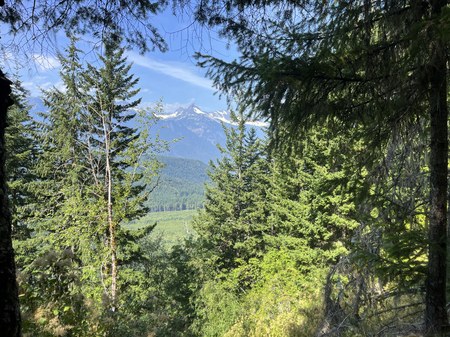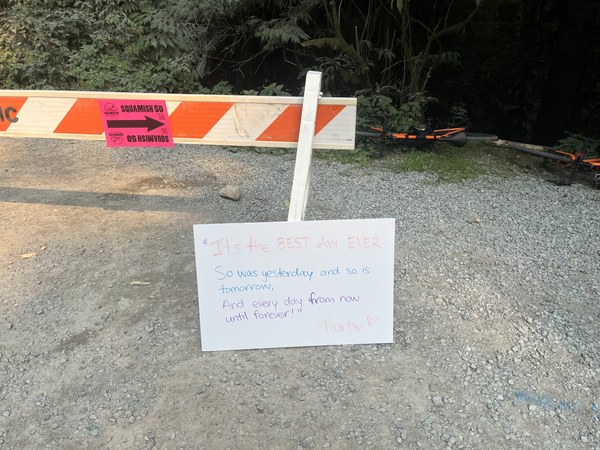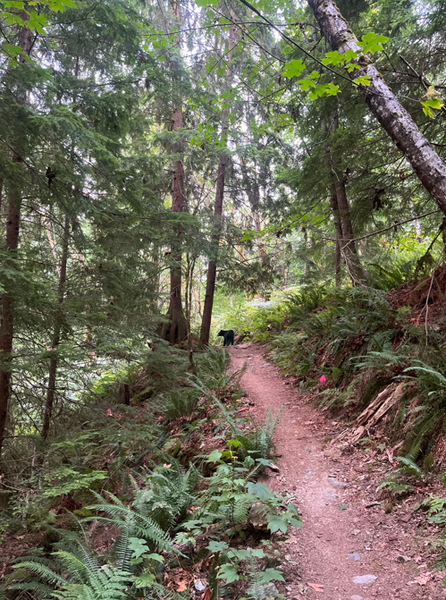
Running is often a solitary sport. Ultra-running is even more solitary. Thirty-mile training runs are a special kind of challenge and not one that my casual running friends are eager to join. Because of this, I train mostly on my own.
In The Mountaineers, we set out on trips together as a team. I’ve been slowly adapting to The Mountaineers team mentality and learning the importance of asking for and accepting help.
Embracing teamwork
Accepting help – both medical and emotional – does not come easily for me.
While running the Squamish 50-mile race in British Columbia last August, I fell near the very beginning of the race. Aid station volunteers dressed as Barbies (because ultra-running aid stations have themes) patched up my bloodied leg. When the temperature hit the 80s, a volunteer (dressed as Ken) filled my water bladder with ice and electrolyte mix while another volunteer (also dressed as Ken) sponged cold water onto my neck. As I exited the final aid station, I read a hand-lettered sign quoting Barbie that cheered me on: “It’s the best day ever, so was yesterday and so is tomorrow, and every day from now until forever.”
Mountaineering has taught me a lot about being willing to ask for help and allowing others to assist me when I’m struggling. In previous years, I would have insisted on ignoring the blood staining my knee-high socks; I would have insisted on refilling my pack on my own and rolled my eyes at such an encouraging trailside poster.
 A handwritten trailside encouragement from Barbie.
A handwritten trailside encouragement from Barbie.
The more time I spend relying on my climbing partners to help carry gear, filter water, share snacks, and identify hazards, the more I see the value in being a part of a team of people while working to accomplish difficult objectives in the mountains. Ultra-running does not have to be a solo sport. It can be improved by accepting the help of others in the same ways we accept the help of our climbing teams.
If the aid stations hadn’t already taught me the lesson that accepting help from others is important, then the bear encounter really hammered it home.
Sharing the trail with runners and wildlife
Kelsey: 6:58 pm, mile 44 - “I just got charged by a bear. Then I got a bloody nose, unrelated to the bear.”
Chad: “Are you ok?!”
Kelsey: “Yeah… just over it.”
At mile 44 of the race, a large black bear was walking along the trail. Being an ultra-runner, I figured if I ran toward it and yelled a couple of times, it would simply run away. (I have encountered bears on my training runs along the Middle Fork and North Bend trails and this strategy has always worked). I was wrong.
The bear did not like being yelled at or followed by some sweaty human. The bear very quickly turned around and charged at me as well as the runner just behind me, closing the distance between us in the blink of an eye.
My reaction and the reaction of the runner behind me were similar. We yelled “AHHH” at the top of our lungs. As the bear swiped its paw across the trail just in front of us and made a “chuffing” sound, we stumbled back down the trail. After coming within a few feet of us, the bear eventually turned away, hackles raised. With little grace, we continued to stumble and jog backward, keeping our eyes open for a repeat bluff all while yelling wildly. We made it down a few switchbacks before running into the next group of runners. The four of us teamed up and made it past the bear’s grazing spot without further incident.
Had I been alone, like I had been during all my previous encounters, I don’t doubt that I would have been in serious trouble. I might have been tempted to run past the bear (not a good idea). I might have been stuck waiting the bear out (who knows how long she was planning on munching those blueberry bushes). Or I might have tried to circumnavigate the bear, risking losing the route altogether or slipping and hurting myself while traveling off-trail. Being mauled by a black bear might be a rare occurrence, but a twisted ankle or a fall down the embankment while trying to evade a bear could mean the end of my racing and mountaineering season.
 A black bear obstructing the running trail.
A black bear obstructing the running trail.
The bear, the kindness of the aid station volunteers, and the support of my friends are all examples of times when ultra-running feels more like a rope team than a solo sport.
The mental game of ultra-running is mostly about suffering for long distances over a long time. Like mountaineering, it is made easier by being in a community with other athletes.
Hopefully, as The Mountaineers continues to expand trail running courses, we will see the two disciplines – running and mountaineering – inform one another. As a Mountaineer, if you are considering ultra-running, consider running with a team. The triumph of completing a long race, the joy and hilarity of an aid station, and the feeling of comradery after facing down a bear are all more rewarding when shared. Whether your team is texting encouragement from the car or taking on the trail with you, ultra-running is best accomplished as a team.
 Kelsey Hoffman
Kelsey Hoffman